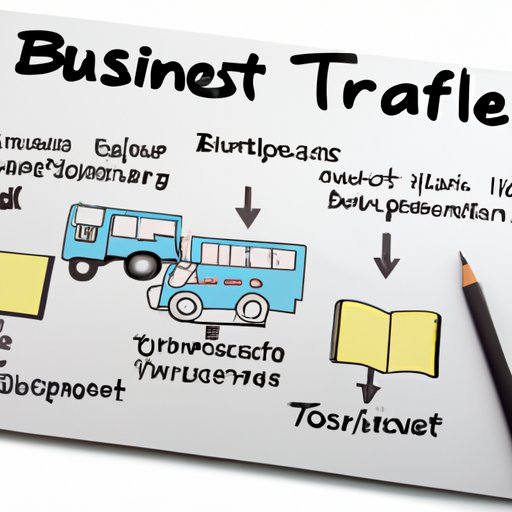Introduction
Starting a transport business can be an exciting endeavor. It requires significant planning, however, to ensure that you are adequately prepared for success. In this article, we will provide an overview of what is involved in starting a transport business, from researching the local market to obtaining necessary licensing and permits to marketing your business.

Research the Local Market for Transport Businesses
Before launching a transport business, it is important to understand the competitive landscape. This means researching your competitors, assessing demand for your services, and analyzing the regulations and requirements for operating a transport business in your area.
Understand Your Competitors
First, you should get a sense of which businesses are already providing similar services in your area. Look into the types of vehicles they offer, the services they provide, their prices, and any other unique features they may have. Knowing what your competition is doing will help you determine what makes your transport business stand out.
Assess Demand for Your Services
It is also essential to assess the demand for your services in the local market. Consider the size of the population in your area and whether there is a need for your services. Additionally, you should look into trends that could impact your business, such as increasing demand for ride-sharing services or changes in transportation technologies.
Analyze Regulations and Requirements
Finally, you should familiarize yourself with the regulations and requirements for operating a transport business in your area. Depending on where you live, these may include licensing requirements, safety regulations, insurance requirements, and more. Researching these regulations ahead of time will help you avoid costly mistakes down the line.

Develop a Business Plan for Your Transport Business
Once you have done your research, it is time to develop a business plan for your transport business. A business plan is a document outlining your goals and objectives, financial needs, strategies, and more. It is a crucial step in the process of starting a business, as it will help you stay organized and focused on the long-term success of your business.
Identify Your Goals and Objectives
Start by identifying your goals and objectives for your transport business. What do you hope to accomplish with your business? How quickly do you want to grow? What areas do you want to specialize in? Answering these questions will help you create a roadmap for your business.
Determine Your Financial Needs
Next, you should assess your financial needs. Calculate the costs of setting up and running your business, such as vehicle purchases, equipment and supplies, and employee salaries. You should also consider any additional expenses, such as advertising and website development.
Outline Your Strategies
Finally, outline the strategies you will use to achieve your goals and objectives. This may include pricing strategies, customer service strategies, marketing plans, and more. Having a clear strategy in place before you launch your business will help you stay organized and focused.
Obtain Necessary Licensing and Permits
Depending on your location, you may need to obtain certain licenses and permits in order to operate a transport business. Check with your state or local government to find out what licenses and permits are required for your business. You should also research any federal regulations that may apply to your business. Finally, make sure you secure the necessary insurance to protect your business.
Check with Your State or Local Government
The first step is to check with your state or local government to find out what licenses and permits are required for your business. These may include a business license, vehicle registration, driver’s license, and more. Make sure you understand what is required and obtain all the necessary documents.
Research Federal Regulations
In addition to state and local regulations, you should research any federal regulations that may apply to your business. According to the Small Business Administration, “If your business transports passengers or hazardous materials, you must comply with Department of Transportation regulations.” Make sure you understand these regulations and adhere to them.
Secure Insurance
Finally, make sure you secure the necessary insurance to protect your business. According to insurance expert Joe White, “Transportation businesses must carry commercial auto insurance to cover the cost of damages resulting from accidents or other incidents involving their vehicles.” Make sure you shop around for the best rates and coverage.

Secure Financing for Your Transport Business
Once you have obtained the necessary licenses and permits, it is time to secure financing for your transport business. There are several options available, including small business loans, private investors, and credit cards. Consider each option carefully to determine which is best for your business.
Look into Small Business Loans
Small business loans are a popular option for financing a transport business. According to the U.S. Small Business Administration, “Most lenders require a business plan and financial statements before approving a loan.” Make sure you have these documents ready when applying for a loan.
Consider Private Investors
Another option is to seek out private investors. Private investors may be willing to invest in your business if they believe it has potential for growth. Be prepared to present your business plan and answer questions about your business.
Utilize Credit Cards
Finally, you can use credit cards to finance your transport business. Credit cards can be a great way to get short-term financing for purchases or emergency expenses. Just make sure you pay off the balance in full each month to avoid high interest charges.
Purchase Vehicles, Equipment and Supplies
Once you have secured financing, it is time to purchase the vehicles, equipment, and supplies you need to run your business. Choosing the right vehicle type, finding an affordable supplier, and looking into leasing options are all important steps in this process.
Choose the Appropriate Vehicle Type
First, you should decide which type of vehicle is best for your business. According to automotive expert Tom Williams, “You should consider factors such as capacity, fuel efficiency, safety, and cost when selecting a vehicle type.” Make sure you choose a vehicle that meets your needs and budget.
Find an Affordable Supplier
Next, you should find an affordable supplier for your vehicles, equipment, and supplies. Shop around to compare prices and look for discounts or special offers. You may also be able to negotiate better terms with suppliers if you commit to a larger order.
Look Into Leasing Options
Finally, consider looking into leasing options for your vehicles. Leasing can be a great way to save money and reduce the upfront cost of purchasing vehicles. According to finance expert John Smith, “Leasing can offer lower monthly payments and a shorter term than traditional financing.”
Hire Employees
To run a successful transport business, you will need to hire qualified employees. Knowing what qualifications to look for, considering outsourcing, and using job boards are all important steps in the hiring process.
Know What Qualifications to Look For
When hiring employees for your transport business, it is important to know what qualifications to look for. Do you need drivers with a commercial driver’s license? Are there specific skills or experience that you require? Make sure you know what qualifications your employees must have before you begin the hiring process.
Consider Outsourcing
You may also want to consider outsourcing certain tasks, such as bookkeeping or customer service. Outsourcing can be a great way to save time and money, as you don’t have to worry about hiring and training employees. However, make sure you thoroughly vet any companies you work with to ensure they meet your standards.
Use Job Boards
Finally, you can use job boards to find qualified candidates for your open positions. Sites like Indeed, Monster, and Glassdoor are great places to post job listings and attract qualified applicants. Make sure you include detailed descriptions of the positions and the qualifications you are looking for.
Market Your Transport Business
Once you have hired employees and purchased the necessary vehicles, equipment, and supplies, it is time to start marketing your business. Creating a website, utilizing social media platforms, and networking with other businesses are all great ways to promote your business.
Create a Website
Creating a website is one of the most effective ways to market your business. It gives potential customers a place to learn more about your business and contact you for more information. Make sure your website is professional, informative, and easy to navigate.
Utilize Social Media Platforms
Social media platforms like Facebook, Twitter, and Instagram are great tools for promoting your business. Post updates about your services, share photos of your vehicles, and engage with your followers. Just make sure you post regularly and respond to any questions or comments.
Network with Other Businesses
Finally, networking with other businesses can be a great way to market your transport business. Reach out to local businesses in your area and see if they are interested in partnering with you. You may also be able to refer customers to each other or collaborate on promotions and special offers.
Conclusion
Starting a transport business requires significant planning and preparation. Researching the local market, developing a business plan, obtaining necessary licensing and permits, securing financing, purchasing vehicles, hiring employees, and marketing your business are all important steps in the process. With the right approach and dedication, you can create a successful transport business.
Summary of Main Points
This article provided an overview of what is involved in starting a transport business. We discussed researching the local market, developing a business plan, obtaining necessary licensing and permits, securing financing, purchasing vehicles, hiring employees, and marketing your business.
Final Words of Advice
Starting a transport business is no easy task, but it can be very rewarding. Make sure you do your research, create a thorough business plan, obtain the necessary licenses and permits, secure financing, purchase vehicles, hire employees, and market your business effectively. With hard work and dedication, you can create a successful transport business.
(Note: Is this article not meeting your expectations? Do you have knowledge or insights to share? Unlock new opportunities and expand your reach by joining our authors team. Click Registration to join us and share your expertise with our readers.)
